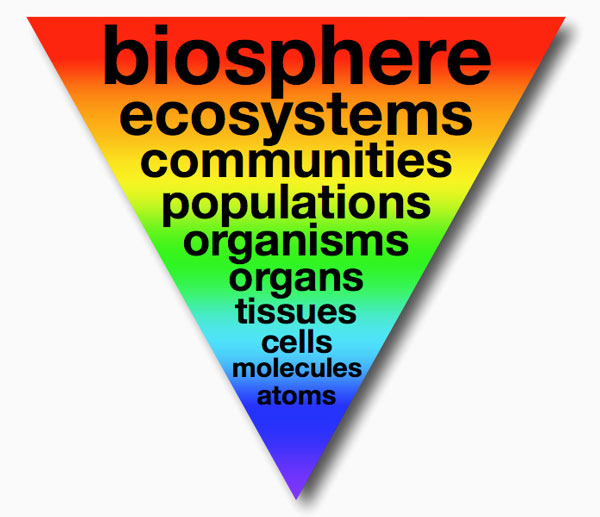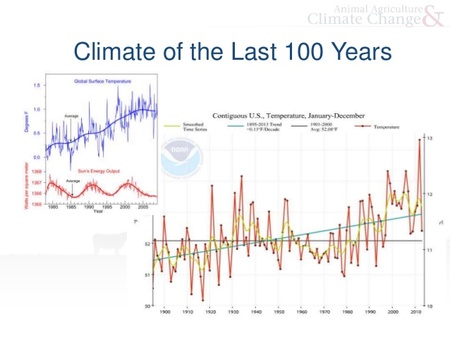topic 1.2: systems and Models
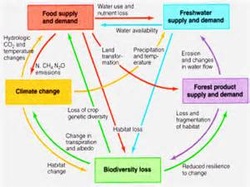
A system is an assemblage of parts, working together, forming a functional whole. Many types of environmental systems exist. From cells, to people, to cars, to economies to the whole planet. Systems occur on different scales.
The systems approach is central to the course and has been employed for a number of reasons. The very nature of environmental issues demands a holistic treatment. In reality, an environmental system functions as a whole and the traditional reductionist approach of science inevitably tends to overlook or, at least, understate this important quality. Furthermore, the systems approach is common to many disciplines (for example, economics, geography, politics, ecology). It emphasizes the similarities between the ways in which matter, energy and information flow (not only in biological systems but in, for example, transport and communication systems). This approach therefore integrates the perspectives of different disciplines.
In this unit you will be introduced to the characteristics of environmental systems. Identifying some of the underlying principles that can be applied to living systems, from the level of the individual up to that of the whole biosphere.
This unit will take a minimum of 2.5 hours.
The systems approach is central to the course and has been employed for a number of reasons. The very nature of environmental issues demands a holistic treatment. In reality, an environmental system functions as a whole and the traditional reductionist approach of science inevitably tends to overlook or, at least, understate this important quality. Furthermore, the systems approach is common to many disciplines (for example, economics, geography, politics, ecology). It emphasizes the similarities between the ways in which matter, energy and information flow (not only in biological systems but in, for example, transport and communication systems). This approach therefore integrates the perspectives of different disciplines.
In this unit you will be introduced to the characteristics of environmental systems. Identifying some of the underlying principles that can be applied to living systems, from the level of the individual up to that of the whole biosphere.
This unit will take a minimum of 2.5 hours.
Significant Ideas:
- A systems approach can help in the study of complex environmental issues
- The use of systems and models simplifies interactions but may provide a more holistic view without reducing issues to single processes
Big questions:
- What strengths and weaknesses of the systems approach and the use of models have been revealed through this topic?
- How does a systems approach facilitate a holistic approach to understanding?
- What are the strengths and weaknesses of the systems you have examined in this section?
- What have you learned about models and how they can be used, for example, to predict climate change? Do their benefits outweigh their limitations?
Knowledge and Understanding
1.2.U1 A systems approach is a way of visualizing a complex set of interactions which may be ecological or societal. (Guidance: A systems approach should be taken for all the topics covered in the ESS
course)
course)
- Define systems
- Explain the component parts and the emergent properties of a system.
- Outline the concept and characteristics of systems.
- Outline the Gaia Hypothesis
- Using an example, describe the concept of systems diagrams. Include the descriptors of flows, storages, transfers, transformations, and feedback loops.
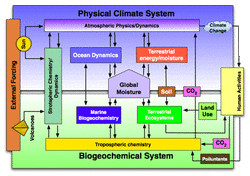 image from sciencebitz.com
image from sciencebitz.com
SYSTEM: an assemblage of parts and their relationship forming a functioning entirety or whole. There are two major components to a system:
During the 1970’s, British chemist James Lovelock and American biologist Lynn Margulis came up with the GAIA HYPOTHESIS: That the world acts like a single biological being made up of many individual and interconnected units (A SYSTEM ).
A systems approach is a way of visualizing a complex set of interactions which may be ecological or societal. These interactions produce the emergent properties of the system
- Elements - measurable things that can be linked together. Example, trees, shrubs, herbs, birds and insects (items we can count, measure or weight
- Processes - change elements from on form to another. These may also be called activities, relations, or functions. Example, growth, mortality, decomposition, and disturbances (what happens to the elements, or what the elements do)
During the 1970’s, British chemist James Lovelock and American biologist Lynn Margulis came up with the GAIA HYPOTHESIS: That the world acts like a single biological being made up of many individual and interconnected units (A SYSTEM ).
A systems approach is a way of visualizing a complex set of interactions which may be ecological or societal. These interactions produce the emergent properties of the system
- Why the system as a whole is greater than the sum of its parts
- The interactions of the parts create something they could not produce independently
- ex: two forest stands may contain the same tree species, but the spatial arrangement and size structure of the individual trees will create different habitats for wildlife species. In this case, an emergent property of each stand is the wildlife habitat
1.2.U2 These interactions produce the emergent properties of the system
- Describe the emergent properties
A holistic approach is necessary to fully understand the way in which the parts of a complex system operates togher. An emergent property is a property which a collection or complex system has, but which the individual members do not have. A failure to realize that a property is emergent, or supervenient, leads to the fallacy of division.
1.2.U3 The concept of a system can be applied at a range of scales. (Guidance: Biosphere refers to the part of the Earth inhabited by organisms that extends from the upper parts of the atmosphere to deep within the Earth’s
crust.)
crust.)
- Explain, using examples, that systems can vary in size.`
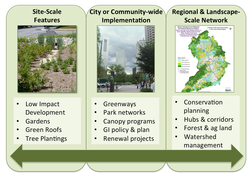
There are different scales of systems. The range must include a small-scale local ecosystem, a large ecosystem such as a biome, and Gaia as an example of a global ecosystem. Forests contain many small-scale ecosystems.
1.2.U4 A system is comprised of storages and flows
- Describe the structure of a system
- Distinguish between flows (inputs and outputs) and storages (stock) in relation to systems
- List two examples of storage
- List two examples of flows
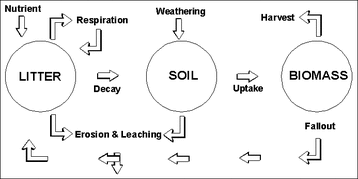
All living things use energy to do everything. Ecologists trace the flow of energy through ecosystems to identify nutritional relationships. The ultimate source of energy for nearly all living things is the sun.
Ecologists who trace energy and matter flow in ecosystems have identified a number of interesting things. Energy flows from one organism to another as each organism is eaten by the next. These relationships are called food chains. For example, a plant may capture the sun's energy then become food for a deer which may then be eaten by a bear. Each organism forms a link in the chain.
Ecologists who trace energy and matter flow in ecosystems have identified a number of interesting things. Energy flows from one organism to another as each organism is eaten by the next. These relationships are called food chains. For example, a plant may capture the sun's energy then become food for a deer which may then be eaten by a bear. Each organism forms a link in the chain.
1.2.U5 The flows provide inputs and outputs of energy and matter.
- Describe the flow of energy and matter into and out of a system
- Explain the differences between energy flows and matter cycles.
- Define inputs, outputs and stock
- List two examples of inputs
- List two examples of outputs
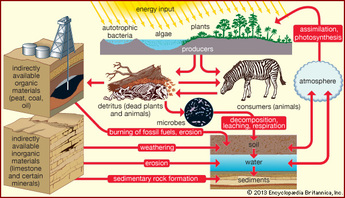
Energy flows from one compartment to another in the form of carbon–carbon bonds. When one organism eats another organism the energy that moves between them is in the form of stored chemical energy.
Inputs and outputs from systems are called flows and represented by arrows in system diagrams. The stock held within a system is called the storage and is represented through boxes
Inputs and outputs from systems are called flows and represented by arrows in system diagrams. The stock held within a system is called the storage and is represented through boxes
1.2.U6 The flows are processes that may be either transfers (a change in location) or transformations (a change in the chemical nature, a change in state or a change in energy
- Explain with the use of examples the differences between transfers and transformations.
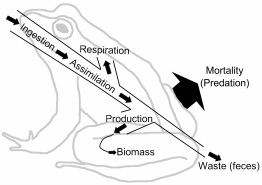
Transfers:
Transformations:
The flows are processes that may be either transfers (a change in location) or transformation (a change in the chemical nature, a change in state or a change in energy) Transfers normally flow through a system and involve a change in location. Transformations lead to an interaction within a system in the formation of a new end product, or involve a change of state. Using water as an example, run-off is a transfer process and evaporation is a transformation process. Dead organic matter entering a lake is an example of a transfer process; decomposition of this material is a transformation process.
Transfers include
Transformations include
- The movement of material through living organisms
- Movement of material in non-living process
- The movement of energy
Transformations:
- Matter to matter
- Energy to energy
- Matter to energy
- Energy to matter
The flows are processes that may be either transfers (a change in location) or transformation (a change in the chemical nature, a change in state or a change in energy) Transfers normally flow through a system and involve a change in location. Transformations lead to an interaction within a system in the formation of a new end product, or involve a change of state. Using water as an example, run-off is a transfer process and evaporation is a transformation process. Dead organic matter entering a lake is an example of a transfer process; decomposition of this material is a transformation process.
Transfers include
- harvesting of forest products
- fall of forest debris on the ground
Transformations include
- photosynthesis
- respiration
1.2.U7 In system diagrams, storages are usually represented as rectangular boxes and flows as arrows, with the direction of each arrow indicating the direction of each flow. The size of the boxes and the arrows may be representative of the size/magnitude of the storage or flow. (Guidance Students should interpret given system diagrams and use data to produce their own for a variety of examples, such as carbon cycling, food
production and soil systems.)
production and soil systems.)
- Define storages
- Define flows
- Draw a systems diagram. Use examples of a real systems diagram
- Interpret data from a stated systems diagram
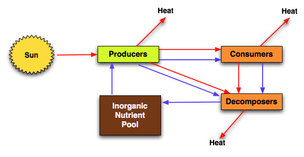 image from yesitsyomoma.wordpress.com
image from yesitsyomoma.wordpress.com
System diagrams consist of:
Diagram can be labelled with the processes on each arrow:
The size of the boxes and arrows in the systems diagram an be drawn to represent the magnitude of the storage or flow.
- boxes show storages
- arrows show flows (inputs/outputs)
Diagram can be labelled with the processes on each arrow:
- Photosynthesis – transformation of CO2, H2o and light into biomass and oxygen O2
- Respiration – transformation of biomass into CO2 and water
- Diffusion – movement of nutrients and water
- Consumption – tissue transfer from trophic level to another
The size of the boxes and arrows in the systems diagram an be drawn to represent the magnitude of the storage or flow.
1.2.U8 An open system exchanges both energy and matter across its boundary while a closed system exchanges only energy across its boundary.
- Define and use the term open system. Use examples of real systems to characterize an open system
- Define and use the term closed system. Use examples of real systems to characterize an closed system.
- Describe closed, open, and isolated systems in terms of matter and energy exchange
- Draw systems diagrams of an open, closed, and isolated system
- Using the terms open, closed, and/or isolated system describe a population of elephants living on an African grassland.
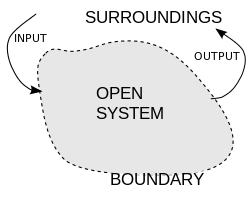
An open system is a system that regularly exchanges feedback with its external environment. Open systems are systems, of course, so inputs, processes, outputs, goals, assessment and evaluation, and learning are all important. Aspects that are critically important to open systems include the boundaries, external environment and equifinality.
Healthy open systems continuously exchange feedback with their environments, analyze that feedback, adjust internal systems as needed to achieve the system’s goals, and then transmit necessary information back out to the environment.
Healthy open systems continuously exchange feedback with their environments, analyze that feedback, adjust internal systems as needed to achieve the system’s goals, and then transmit necessary information back out to the environment.
1.2.U9 An isolated system is a hypothetical concept in which neither energy nor matter is exchanged across the boundary.
- Define and use the term isolated system. Use examples of real systems to characterize an isolated system
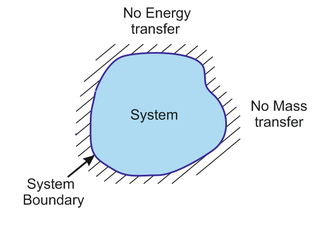
A closed system in which there is no transfer of mass takes place across the boundaries of system but energy transfer is possible. Other than the universe itself, an isolated system does not exist in practice. However, a very well insulated and bounded system with negligible loss of heat is roughly an isolated system, especially when considered within a very short amount of time.
1.2.U10 Ecosystems are open systems; closed systems only exist experimentally, although the global geochemical cycles approximate to closed systems.
- Define open, closed and isolated systems
 image from www.geosci.ipfw.edu
image from www.geosci.ipfw.edu
Systems can be thought of as fitting into one of three types:
- Open systems: exchanges matter and energy
- Closed systems: exchanges only energy
- Isolated systems: neither matter nor energy and is theoretical
1.3.U11 A model is a simplified version of reality and can be used to understand how a system works and to predict how it will respond to change.
- Explain, using examples, what models are.
- Apply the systems concept on a range of scales.
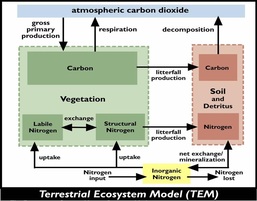 image from www.eaps.purdue.edu
image from www.eaps.purdue.edu
A model is a simplified description designed to show the structure or workings of an object, system or concept. In practice, some models require approximation techniques to be used. For example, predictive models of climate change may give very different results. In contrast, an aquarium may be a relatively simple ecosystem but demonstrates many ecological concepts.
Models summarize complex systems. Therefore they can lead to loss of information and oversimplification. A model involves some approximation and therefore losses accuracy.
Models summarize complex systems. Therefore they can lead to loss of information and oversimplification. A model involves some approximation and therefore losses accuracy.
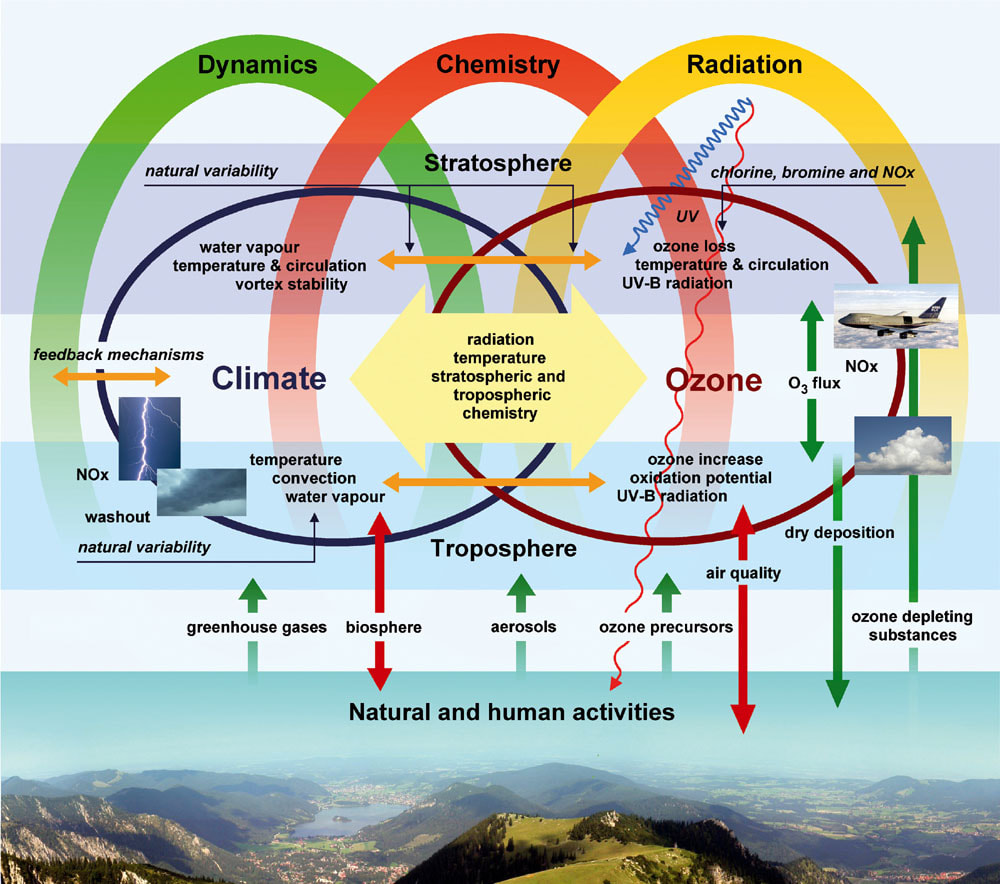
image from https://earth.esa.int/web/guest/sciamachy-handbook-version-2;jsessionid=C1073669E91C3E35D034E935DECF14A1.jvm2?p_p_id=36&p_p_lifecycle=0&p_p_state=pop_up&p_p_mode=view&controlPanelCategory=portlet_36&_36_struts_action=%2Fwiki%2Fview&_36_nodeName=SCIAMACHY+Handbook+2.0&_36_title=Anthropogenic+Impact+on+the+Earth-Atmosphere+System
1.2.U12 A model inevitably involves some approximation and therefore loss of accuracy.
- Evaluate the strengths and limitations of systems models.
Strengths:
- allow scientist to predict/simplify complex systems
- inputs can be changed and outcomes examined without having to wait for real events.
- results can be shown to scientists and the public
- might not be totally accurate
- environmental factors are very complex
- different models use slightly different data to calculate predictions
- rely on the expertise of people making them
- different people may interpret them in different ways
- vested interests might hijack them politically
- any model is only as good as the data goes in and these may be suspect
- different models may show different effects using the same data
Application and Skills
1.2.A1 Evaluate the use of models as a tool in a given situation, for example, climate change predictions.
- Define model
- Evaluate the strengths and limitations of climate change models.
- Using an example, evaluate the use of models as a tool.
Below are 5 different climate model simulations. You should be able to discuss the strengths and weakness of each of these models. Which model do you believe is the best for understanding climate change? Justify your reasoning!
Concord Consortium Climate Model
Window's to the Universe Climate Model
Koshland Science Museum Climate Model
UCAR Climate Model
Java Climate Model
Concord Consortium Climate Model
Window's to the Universe Climate Model
Koshland Science Museum Climate Model
UCAR Climate Model
Java Climate Model
1.2.S1 Construct a system diagram or a model from a given set of information. (Guidance: Students should interpret given system diagrams and use data to produce their own for a variety of examples, such as carbon cycling, food production and soil systems.)
- Construct and analyze quantitative models involving flows and storages in a system.
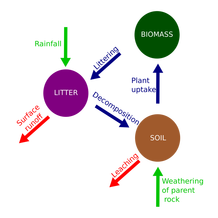
To make an ecosystem (diagram/ model) showing how an ecosystem works. It must contain at least three types of each of the following: abiotic elements, plants, herbivores, carnivores, and omnivores. Organism numbers must have the necessary resources in the ecosystem to maintain its carrying capacity.
You are expected to be able to apply a systems approach to all of the topics in this course. You should be able to interpret system diagrams and use data to produce your own for a variety of examples.
Key Terms
|
system
system approach reductionism synergy Gaia hypothesis biosphere |
emergent properties
model flows inputs outputs ecosystem |
transfer
storage processes assemblage matter transformation |
open system
closed system isolated system stock boundaries |
Classroom Resources
Lake Lanier as a System Case Study
Gaia Hypothesis Activity – Daisy World
Inside Biosphere 2
Making Pancakes as a System activity
Modeling Climate online activity
Case Studies
Be able to identify and describe inputs, outputs, processes, transfers, transformations, and storages of both matter and\ energy for systems at different scales, including specific examples
Lake Lanier as a System Case Study
Gaia Hypothesis Activity – Daisy World
Inside Biosphere 2
Making Pancakes as a System activity
Modeling Climate online activity
Case Studies
Be able to identify and describe inputs, outputs, processes, transfers, transformations, and storages of both matter and\ energy for systems at different scales, including specific examples
- Biosphere 2
- plant and animal cells
- individual organism (one producer, one consumer)
- farming systems
- different ecosystems
Powerpoint and Notes Adapted from Brad Kremer, P Brooks and Ms. McCrindle
Your browser does not support viewing this document. Click here to download the document.
Your browser does not support viewing this document. Click here to download the document.
Correct use of terminology is a key skill in ESS. It is essential to use key terms correctly when communicating your understanding, particularly in assessments. Use the quizlet flashcards or other tools such as learn, scatter, space race, speller and test to help you master the vocabulary.
Useful links
Science Sauce Topic 1.2 Systems Approach
Systems and Models Revision
Systems Thinking, Systems Tools and Chaos Theory - Pearson Education Hotlink
Gaia Hypothesis - Physical Geography
The Earths AtmosphereThe Layered Atmosphere - Physical Geography
Biosphere 2 - University of Arizona
National Ice and Snow Databank - National Snow and Ice Center
Climate Interactive Models - Concord Consortium
The Globe Program
Open, Closed & Isolated Systems
In The News
Hurricane Sandy: Global warming, pure and simple - SALON 31 Oct 2012
Energy Economics in Ecosystems - The Knowledge Project
Earth System Modeling Must Become More Energy Efficient - Eos July 2020
International-Mindedness
TOK:
Video Clips
Science Sauce Topic 1.2 Systems Approach
Systems and Models Revision
Systems Thinking, Systems Tools and Chaos Theory - Pearson Education Hotlink
Gaia Hypothesis - Physical Geography
The Earths AtmosphereThe Layered Atmosphere - Physical Geography
Biosphere 2 - University of Arizona
National Ice and Snow Databank - National Snow and Ice Center
Climate Interactive Models - Concord Consortium
The Globe Program
Open, Closed & Isolated Systems
In The News
Hurricane Sandy: Global warming, pure and simple - SALON 31 Oct 2012
Energy Economics in Ecosystems - The Knowledge Project
Earth System Modeling Must Become More Energy Efficient - Eos July 2020
International-Mindedness
- The use of models facilitates international collaboration in science by removing language barriers that may exist.
TOK:
- Models are simplified constructions of reality-in the construction of a model, how can we know which aspects of the world to include and which to ignore?
Video Clips
Observe the events that show how Earth works as a set of interconnected systems.
In this video Paul Andersen explains how matter and energy are conserved within the Earth's system. Matter is a closed system and Energy is open to the surroundings. In natural systems steady state is maintained through feedback loops but can be be affected by human society.
David Suzuki talks with James Lovelock about the origins of his "Gaia" hypothesis, which suggests that the Earth is one organism. From the documentary series "The Sacred Balance",
This is the 2nd segment of a 12 minute overview of the shocking truth about global warming and climate change. This segment deals with the main positive feedback loops in action in Gaia's complex ecosystems: melting of the ice caps, deforestation, melting of permafrost regions of the planet and the destruction of Ehux: a vital marine algae that is a key component of the earth's climate regulation system.
Life is powerful, and in order to understand how living systems work, you first have to understand how they originated, developed and diversified over the past 4.5 billion years of Earth's history. Hang on to your hats as Hank tells us the epic drama that is the history of life on Earth
Jane Poynter tells her story of living two years and 20 minutes in Biosphere 2 -- an experience that provoked her to explore how we might sustain life in the harshest of environments.
